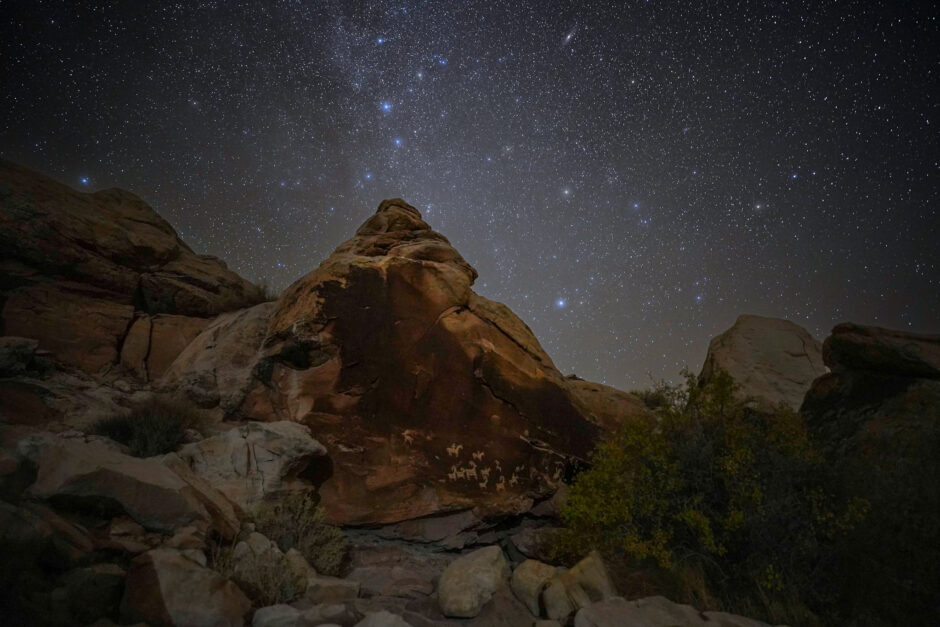
Origins: Petroglyphs, the Milky Way, and a Conversation Across Time
Under the vast night sky of the Utah desert, Nat Hab staff member and guide Charlie Sandbo found himself standing before an ancient sandstone canvas. Petroglyphs etched by early peoples thousands of years ago stretched across the base of a towering boulder near the trail to Delicate Arch in Arches National Park. Above, the Milky Way arched in a luminous sweep, with the faint smudge of the Andromeda Galaxy hovering in the distance. Together, the rock art and the stars formed a bridge between human history and cosmic time.
Charlie titled this photograph “Origins,” a nod to the deep lineage of both its subjects; the ancestors who carved these images and the celestial bodies that have glowed overhead for millennia. The October evening had been still and dark, the clock nearing 10 p.m. as he set up his tripod. His equipment and settings allowed him to pull in the dim light of the stars while preserving detail in the foreground. In some compositions, he took advantage of passing car headlights, letting them wash the sandstone in a warm glow before refining the exposure in post-processing.
His settings for “Origins”
- Camera: Sony A73
- Lens: 20mm f/1.8
- Shutter Speed: 20sec
- Aperature: f/1.8
- ISO: 6400
He had first noticed the location by daylight while hiking back from Delicate Arch for sunrise. That scouting (part of his standard approach to new destinations) helped him identify promising astro spots during the less photogenic midday hours. “Parks are wonderful during the day,” Charlie says, “but at night they take on a whole new life, and you often have the place to yourself.”
Capturing both the petroglyphs and the night sky posed a technical challenge. For pinpoint stars, he focused directly on them, then sharpened the foreground during editing to ensure clarity. He cooled the sky’s tones in Lightroom to counteract the light pollution from nearby Moab and the occasional headlights that swept the trail.
This was the image he had envisioned, though he admits luck played a role. Without consulting an app for star placement, he arrived to find the Milky Way and Andromeda positioned perfectly above the rock art. “If I could redo the shot,” he says, “I’d come back during a meteor shower or other astronomical event. That would take it to another level.”
Charlie offers practical advice for aspiring astro-landscape photographers: avoid sweeping, heavy edits that can make a night sky look artificial. Instead, make small, targeted adjustments, using masking tools to highlight specific areas while staying true to the scene. And always shoot more frames than you think you’ll need, varying aperture and ISO, to give yourself options later. “You can’t easily go back,” he says, “and you never know when a shooting star might streak through your composition.”
Reflecting on this desert setting, Charlie recalls a favorite quote by Paul Shepard: “To the desert go prophets and hermits; through deserts go pilgrims and exiles. Here the leaders of the great religions have sought the therapeutic and spiritual values of retreat, not to escape but to find reality.” Standing under the same stars the petroglyph artists once saw, he found that reality etched in stone and scattered in light.
You can find more from Charlie Sandbo at his website and on Instagram.
Leave a reply